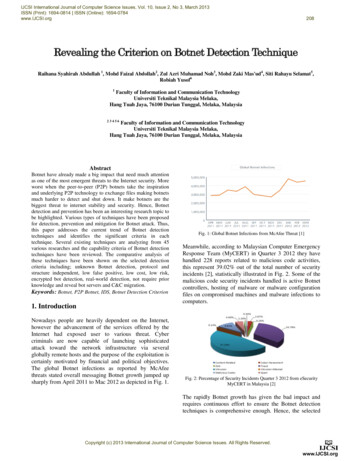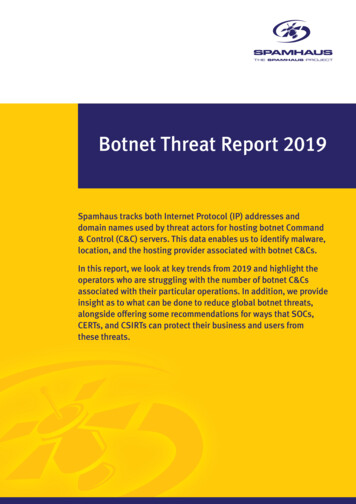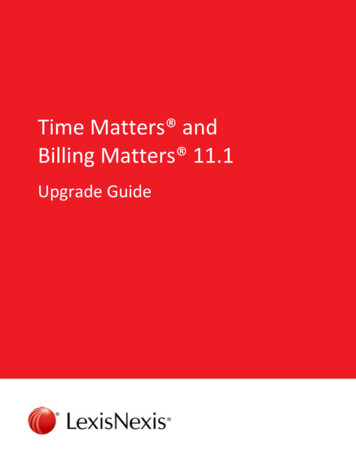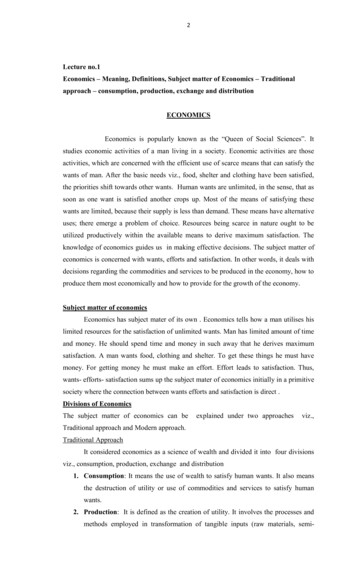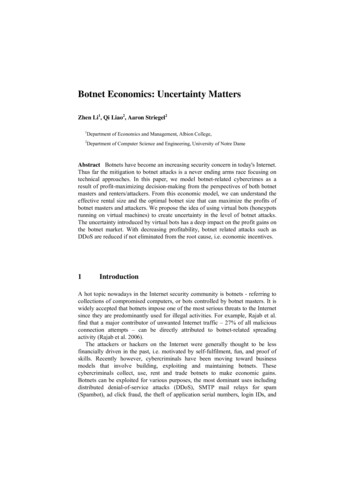
Transcription
Botnet Economics: Uncertainty MattersZhen Li1, Qi Liao2, Aaron Striegel21Department of Economics and Management, Albion College,2Department of Computer Science and Engineering, University of Notre DameAbstract Botnets have become an increasing security concern in today's Internet.Thus far the mitigation to botnet attacks is a never ending arms race focusing ontechnical approaches. In this paper, we model botnet-related cybercrimes as aresult of profit-maximizing decision-making from the perspectives of both botnetmasters and renters/attackers. From this economic model, we can understand theeffective rental size and the optimal botnet size that can maximize the profits ofbotnet masters and attackers. We propose the idea of using virtual bots (honeypotsrunning on virtual machines) to create uncertainty in the level of botnet attacks.The uncertainty introduced by virtual bots has a deep impact on the profit gains onthe botnet market. With decreasing profitability, botnet related attacks such asDDoS are reduced if not eliminated from the root cause, i.e. economic incentives.1IntroductionA hot topic nowadays in the Internet security community is botnets - referring tocollections of compromised computers, or bots controlled by botnet masters. It iswidely accepted that botnets impose one of the most serious threats to the Internetsince they are predominantly used for illegal activities. For example, Rajab et al.find that a major contributor of unwanted Internet traffic – 27% of all maliciousconnection attempts – can be directly attributed to botnet-related spreadingactivity (Rajab et al. 2006).The attackers or hackers on the Internet were generally thought to be lessfinancially driven in the past, i.e. motivated by self-fulfilment, fun, and proof ofskills. Recently however, cybercriminals have been moving toward businessmodels that involve building, exploiting and maintaining botnets. Thesecybercriminals collect, use, rent and trade botnets to make economic gains.Botnets can be exploited for various purposes, the most dominant uses includingdistributed denial-of-service attacks (DDoS), SMTP mail relays for spam(Spambot), ad click fraud, the theft of application serial numbers, login IDs, and
2Managing Information Risk and the Economics of Securityfinancial information such as credit card numbers and bank accounts, etc. Almostall these tasks can be used to make money or have the potential to make money.Researchers and Internet Service Providers (ISPs) have largely exploredsophisticated technical only solutions with limited success. Recent trends note thatthe problems themselves are only growing, not abating. Existing technicalapproaches aim at either to prevent infected machines from reaching the target, orto redirect the visit of infected computers to a different site (Mahajan et al. 2002;Yau et al. 2005). Such defenses tend to be passive and inefficient mainly becausecurrent Internet architecture makes it extremely hard if not possible to differentiatea “pretend-to-be-legitimate” request from a “true legitimate” visit. Especially asbotnets evolve quickly to become a significant part of the Internet, they are alsoincreasingly hidden. New directions of thinking and effective alternatives areimminently required to deal with the problems at the root cause.Today's botnet masters and attackers are seeking money, driven by profits, andmotivated more by a desire to gain financially than to create havoc. Taking awaythe financial incentives that lead them to join malicious Internet activities in thefirst place is hence a promising new line of thinking in fighting the battle againstbotnet attacks. This study explores the worth and benefits by learning fromeconomics and applys economic theories in the analysis of botnet-based attacksand activities.Rational people think at the margin, one of the essential economic principles,suggests that when making economic decisions, people compare costs andbenefits, and will only do things if the benefit of doing it exceeds the costs. Thecost-benefit analysis would guarantee the maximum profit to an economic agent.Applying the principle to for-pay attacks or other illegal activities, both botnetmasters and attackers (who rent bots from previous) are by nature economicagents who participate in the botnet market seeking for economic returns. Similarto other rational behaviors like consumers or firms, botnet masters/attackers makeeconomic decisions in order to reach the highest level of satisfaction, i.e., profitdriven botnet masters and attackers make their decisions regarding the optimalsize of botnets, the effective size of bot rental, etc. to reap the maximum level ofprofit. Based upon the above, the contribution of this study is the systematicmodeling of the botnet operation and utilization as a result of profit-maximizingdecision-making from the perspectives of both botnet masters and attackers. Theeconomic model developed in this study can help understanding the interactionbetween botnet masters, attackers, and defenders, the effective rental size and theoptimal botnet size, cost and benefit, and many other aspects.Another key contribution of this paper is to propose an interesting economicsolution to the botnet problem. By introducing virtual bots (honeypots running onvirtual machines that are to be compromised by the botnet masters), we createuncertainties and interference in the botnet market. As shown in this paper, theseuncertainties have a tremendous impact on the effective botnet size and thereforethe profitability of botnet operators and attackers. Botnet masters and attackers,being profit-driven rational economic agents, make decisions to seek the
Botnet Economics: Uncertainty Matters3maximized profit, whose level depends on factors such as costs of operatingbotnets, payoff received for successfully disabling victim web sites, market rentalprice of botnets, etc. Given rational profit-driven botnet masters and attackers,both the size of rental and the size of botnets determined on a honeypot-freeInternet black market are economically efficient. At any point in time, the capacityof the server limits the number of compromised machines supported, furtherlimiting the number of bots rent and used to attack victims (Rajab et al. 2007).Therefore, having virtual bots in botnets reduces the probability of launching asuccessful attack and thus reduces the profitability of botnet market. The profitmargin of the market is reduced not only through lowering revenue levels ofmarket participants, but also through increasing costs of operating botnets. Withfalling profit margins, botnets and the associated attacks will eventually decreaseif not outright disappear.The remainder of the paper is organized as follows. Sect. 2 discusses technicalbackground on botnet style DDoS attacks and defense mechanism, our threatmodel and the related work. Sect. 3 develops the assumptions, the variables, andprofit levels of botnet masters and attackers in the benchmark model where virtualbots are not around. The profit maximization problem is formalized for bothbotnet masters and attackers. The fact of modeling botnet masters' and attackers'decision-making as a profit maximization problem allows us to find the optimalsizes of botnets, honeypots, and rentals used for attacks. Sect. 4 extends thebenchmark model to accommodate the existence of honeypots. We first assumethe probability for a rental machine to be virtual is fixed, and then relax theassumption to analyze a more informative case in which the probability of fakebots is unknown to botnet masters and attackers. It also describes how this methodcan be used to understand and undermine botnet attacks from the root cause, i.e.economic incentives. The impacts on botnet masters, attackers, and defendersintroduced by this uncertainty are analyzed in detail. Sect. 5 discusses technicaldeployment feasibility and a few challenges. We walk through examples withconcrete numeric values coupled with graphical illustration. Finally, we concludeand propose future work in Sect. 6.2Background and Related workIn a botnet-style distributed denial of service (DDoS) attack, the attacker choosesa subset of botnets to either flood or consume end servers resources. Since thoserequests are not spoofed, they appear all legitimate, but much more intensely thannormal use and causes the system to become busy, rendering the site unavailableto other legitimate users. Regardless of the type of DDoS attack, bandwidthdepletion or resource depletion schemes, the goal of a DDoS attack is to impairthe target's functioning, effectively shutting down the victim by forcing it to spend
4Managing Information Risk and the Economics of Securityresources handling the attacker's traffic. An example of the botnet DDoS attack isillustrated in Figure 1.Figure 1. A Scenario of Botnet Attacks Launched by Robot Computers(bots) Controlled by the Botnet Master and Attacker.Defending against botnet DDoS attacks is an extremely challenging problem.Traditionally, defenses against those attacks have focused only on technicalsolutions. Approaches include rate limiting/filtering the offense hosts (Mahajan etal. 2002; Yau et al. 2005), tracing back (Park and Lee 2001; Savage et al. 2000;Snoeren et al. 2001), or host-based anomaly filtering (Jin et al. 2003, Jin andYeung 2004; Xu and Lee 2003). These methods require either accuratelyidentifying the source as “bad” or “good”, constant updating signatures, or supportfrom network architecture. This results in a never ending arms race betweenattackers and defenders, which is an undesirable position for a content provider.We note that as researchers become more aware of the economic nature ofInternet security problems, recent research has been seeking help from economicprinciples. To stem the flow of stolen credit cards and identity thefts, Franklin andPerrig propose two technical approaches to reduce the number of successfulmarket transactions, aiming at undercutting the cybercriminals verification orreputation system (Franklin and Perrig 2007). The approach by Xu and Lee usesgame theory to model the attackers and defenders (Xu and Lee 2003). Althoughtheir approach is by nature a technical DDoS defense, it is interesting to noticethat they use a game-theoretical framework to analyze the performance of theirproposed defense system and to guide the design and performance turning of thesystem.
Botnet Economics: Uncertainty Matters5The closest study to ours is Ford and Gordon (Ford and Gordon 2006), whichtargets at malicious-code generated revenue streams. We both aim at designingbotnet-disabling mechanisms from an economic perspective that are in the directcontrol of defenders. Nevertheless, there are noticeable differences between thetwo studies. In contrary to the focus on online advertising fraud, our model coversmore general botnet attacks with a threat model focusing more on botnet DDoSattacks. Our contribution is that we model botnet masters' and attackers' decisionmaking as solving a profit maximization problem. Notably, we also incorporatethe diurnal pattern and live population when modeling the botnet behavior.Depending on the optimal strategies botnet masters and attackers adopt, weillustrate in details how honeypots can be deployed to change economicmotivations of illegal Internet practitioners. In this sense, we are in line with theseresearchers by claiming that botnet-related crimes will dramatically decrease ifbotnet masters give up on it – that is, when maintaining botnets becomes moretroublesome than worthwhile.We also propose a fresh new method of using virtual bots to introduce theuncertainties to the optimizing problem through analysis of those virtual bots'impact on the botnet market. Although the idea of honeypots is not new (Bacher etal. 2005), honeypots have primarily been used for data collecting to understand thebotnet or mapping the infected machines to track the control channel rather thanundermining botnets by removing the financial incentives of running andemploying the botnet. By extending the functioning of honeypots in the directionof interfering with the money-driven Internet malicious activities, the value ofhoneypots is fundamentally improved, especially when taking into account thepotential effectiveness of our proposed method.3The Benchmark ModelIn this section, we consider a benchmark model in which virtual machines are notpresent to interfere with the botnet. We present the assumptions of the model, thevariables and constant parameters, and the profit levels of both botnet masters andattackers as a result of their profit maximization decision-making.3.1Profit-driven CybercriminalsInternet-based crimes have been shifting from reputation economy to casheconomy. Today, large fraction of Internet-based crimes is profit driven and canbe modeled roughly as rational behavior. The Internet underground market createsa large fortune. The exponential growth of botnet with millions of infectedcomputers bought and traded on an underground market has evolved into billion-
6Managing Information Risk and the Economics of Securitydollar “shadow industry” (ScienceDaily 2007). Being such a lucrative business,Internet illegal activities have been popular and hard to kill. Any effectiveapproach aiming at eliminating such activities must remove the financialincentives out of them. Economic theories would help.Botnet economics is by nature similar to other economics whereby rationalindividuals driven by profits make economic decisions to maximize their wellbeing. Applying the cost-benefit principle from economics to Internet crimes, abotnet master will keep botnets if the benefit of doing so is larger than the costs.Similarly, attackers will be better off if they commit an action whose benefits arelarger than costs.Evidence has been found that compromised machines are actually rent onunderground markets (Franklin and Perrig 2007). It is realistic to model Internetmarket as the trading place where bots are rent to attackers for launching DDoSattacks. We choose to model botnet-based DDoS attacks first because of itsstraightforwardness. Moreover, (botnet-related) DDoS is still the primary concernfor network security operations (Arbor Network 2006). In the rest of the section,we build a theoretical model to illustrate how the two parties – botnet masters andattackers – make economic decisions in order to reap maximum profit.3.2AssumptionsThe key assumption is the rationality of botnet masters and attackers. For anymarket, there must be a long-run equilibrium in which all market forces have beenbalanced. Suppose the Internet black market is in long-run equilibrium, We notethe following assumptive parameters.1. ne is the minimum number of machines required to achieve a task (e.g.disable a website) 1. We assume that technical capability determines the size of ne,which both botnet masters and attackers take as given. We refer to ne as theeffective number of rentals (and as we will see later, since it costs money to rentbotnets, in the steady state, attackers' profit-maximizing size of rental is equal tone).2. An attacker is only paid if the attack successfully disables the target site. Thepayment received by the attacker is denoted as M.3. The rental price per bot (denoted as P) is determined on Internet blackmarkets, which both botnet masters and attackers take as given.4. Botnet masters who manage bots use Command and Control (C&C) channel2to communicate with zombie computers in botnets. A typical C&C channel can1Alternatively, we can view ne as the minimum number of accesses required to disable a website,and further define the number of accesses per machine to figure out the size of rental. We do notsee it necessary to go into such details and believe our conclusions are not affected.2Although we are considering Internet Relay Chat (IRC), which is dominant C&C channel intoday's botnet, the parameter for botnet maintenance costs can be defined accordingly based on
Botnet Economics: Uncertainty Matters7host q machines simultaneously, which is also the live population on the C&Cchannel at any point in time.3 The unit cost of maintaining a C&C channel is givenat m.5. A real bot machine operates on average t hours per day and d days per weekdue to owner's diurnal patterns and physical constraints. Of all the live population,botnet masters randomly select bots to lease out.In summary, the exogenous/given variables are the effective size of rentals (ne),the number of machines a C&C channel can support at a point in time (q), theaverage cost of maintaining a C&C channel (m), the unit rental price ofcompromised machines (P), the payment for a successful attack (M), and howoften a real machine operates (t and d).3.3 Model Without Virtual MachinesIn the benchmark model, we set up the profit maximization problems for arepresentative botnet master and a representative attacker where virtual machinesare not present to interfere with the botnet. Profit is the difference betweenrevenue and costs, both can be monetary and psychological. Since it is hard tomeasure or quantify psychological benefits and costs, we just focus on themonetary aspect of the analysis.The profit maximization problems for a representative botnet master and arepresentative attacker are as follows, respectively.For the attacker:max ( Profit ) M P nn(1)n nes. t.where the subject condition requires that the attacker must rent at least theeffective number of machines to launch a successful attack.For the botnet master:max ( Profit ) P n m k a ( N )k ,Ns. t.k nqN n(t / 24) (d / 7)(2)the underlying technique adopted to control bots, whether through IRC or other decentralizedsystems such as P2P.3Similar to the determination of ne, how many bots, q, a C&C channel can host is determined bytechnological progresses and limited by the capacity of the channel. Given technology, q is fixed.
8Managing Information Risk and the Economics of Securitywhere N is the size of a typical botnet, which is simply the number of machines ina botnet. N is called the footprint of the botnet. a(N) is the penalty function for thebotnet master, measuring the economic losses suffered from being detected andarrested. Since the chance of being identified and arrested is higher as the size ofthe botnet increases, the penalty function is increasing in the size of the botnet(a’(N) 0). The second restriction for the botnet master implies that the activemembers in the botnet ( N (t / 24) (d / 7) ) must be no smaller than the livepopulation (n) because the botnet master can only rent out active machines. Thefirst restriction for the botnet master suggests that the total number of C&Cchannels must be enough to support the n machines being leased.The control variable for the attacker is the size of rental (n). The controlvariables for the botnet master are the number of C&C channels (k) and the size ofthe botnet (N) to maintain.Given the consideration of both the attacker and the botnet master, the order ofthe decision making and the first-best model solutions are as the following.1. The attacker rents n machines to launch a successful attack; After the victimis taken down, the attacker receives M payment. Since it costs money to rentmachines, at given M, the attacker's profit is maximized at n ne. In other words,in the steady state, the equilibrium number of rental is equal to the effective size ofrental.2. After observing the number of machines the attacker is willing to rent, thebotnet master chooses the size of the botnet to maintain that will satisfy the rentalneeds of the attacker. Without uncertainty, since a typical machine runs t hours aday and d days a week, the steady-state size of the botnet is N n e /{(t / 24) (d / 7)} .Meanwhile, the botnet master needs to maintain enough C&C channels to host thene rental machines. Given the total revenue P ne , maximizing profit isequivalent to minimizing costs, which is further equivalent to maintaining theminimum number of C&C channels k n e / q .From above, when the botnet master and the attacker do not have to worryabout virtual machines, efficient market results are achieved by realizing theeffective level of rental, number of C&C channels, and size of botnet. Withoutuncertainty, the botnet master's and the attacker's benchmark profits aredeterministic. Let πb be the profit earned by the botnet master and πa be the profitfor the attacker, their profit levels can be represented as follows, respectively.π b P ne m nene a q(t/24) (d/7) π a M P ne(3)(4)Examining the expressions of steady-state profits for the botnet master and theattacker, it can be seen that for the existence of the business, both profits must be
Botnet Economics: Uncertainty Matters9non-negative. Combining the botnet master (seller of the botnet) and the attacker(buyer of the botnet), the market is profitable as long as both sides of the marketare profitable,M P ne m nene a q(t/24) (d/7) (5)Adding (3) and (4), the size of the gains on the market isπa πb M m nene a q(t/24) (d/7) (6)On current Internet black markets, the chance for a botnet master to be arrestedis small. The widespread (and increasing) illegal botnet practices suggest that theprofitability of the business may be quite significant, and hence participating inthe market is attractive and rewarding.One thing we do not take into account is the idle time of botnets – the timeperiods when botnets are not leased. The attacks do not happen all the time. Thebotnet master cannot rent the botnet as often as he/she would like. When thebotnet is at idle, it receives no revenue and occurs only costs. The calculation ofprofits in the benchmark model is per successful attack. We can accommodate theconcern of idle time straightforwardly by specifying the profit as the profit reapedin a period of time. The setup and solutions of the model are unchanged.4Optimization Model With Virtual MachinesIn the benchmark model, botnet masters and attackers earn profits and thus willremain in the market. To push them away from the market, we ought to reducetheir profit level and make the business less attractive. Economic theory suggeststhat uncertainty is costly. When market situation becomes less clear for somereason, market participants would be reluctant to do the business and ask forhigher compensation for the increased risks resulting from ambiguity. The ideaprovides a new approach to interfering with Internet underground market – tomake it less efficient and less deterministic. We propose that creating honeypotsfor botnet masters to compromise will do the job.In this section, we extend the benchmark model to allow the existence ofhoneypots in botnet. We first assume that the probability for a rental machine tobe virtual is fixed, and later relax the assumption to analyze a more realistic andinformative case in which market participants have no idea about the number ofhoneypots having been created.
104.1Managing Information Risk and the Economics of SecurityFixed Probability For a Rental Bot Being VirtualThe introduction of virtual machines creates uncertainty to the botnet in large.Virtual bots will not attack the victim as ordered. If still n ne machines wererent, a number of inactive machines would make the attack unsuccessful. Theactual size of rental (n) can no longer be equal to the effective size of rental (ne).With some of n being virtual machines, renting ne is not enough, implying that thenew equilibrium size of rental must be larger than ne.We model the profit maximization problems for the botnet master and theattacker to show what happens with the introduction of virtual machines. For thetime being, we assume that the probability for a rental machine to be virtual isfixed.Let pv denote the probability for a rental machine to be virtual, and pv is fixed.The profit maximization problem for a typical attacker now looks as follows.max ( Profit ) M P nns. t.(7)n (1 p v ) n eFor the botnet master, the profit maximization problem is the same as in thebenchmark model since his/her decision-making is based upon the size of rentalchosen by the attacker.Solving the problems results in two conclusions:1. To launch a successful attack, the attacker now has to rent n n e /(1 p v )machines, larger than in the benchmark model.2. To accommodate the n n e /(1 p v ) machines leased, the botnet master has tomaintain k n e /{(1 p v ) q} C&C channels. In the meantime, the new equilibriumsize of botnet increases toN ne(1 p v ) (t / 24) (d / 7)(8)If everything else remains unchanged, the profit for both the botnet master andthe attacker are different from the benchmark model. For the botnet master, theprofit may either go up or go down. On one hand, the botnet master's revenueincreases due to more machines rent; on the other hand, the botnet master has toacquire more C&C channels to support the increased rental and also suffers ahigher chance of being arrested. The botnet master's profit margin is now:π bv1 P nenene m a ptd1 pv(1 p v ) q(1 ) (/24) (/7)v (9)
Botnet Economics: Uncertainty Matters11where π bv1 represents the profit margin for the botnet master when the probabilityfor a rental machine to be virtual is fixed at pv.The attacker's profit must decline. With the same payment for successfullytaking down the victim, the attacker incurs larger costs of renting machines. Thenew profit level for the attacker is thereforeπ av1 M P ne1 pv(10)where π av1 stands for the profit margin for the attacker when the probability for arental machine to be virtual is fixed at pv.Adding (9) and (10), the size of the total gains on the market shrinks toπ av1 π bv1 M m nene a (1 p v ) q (1 p v ) (t / 24) (d / 7) (11)Obviously, the existence of virtual machines lowers the incentives for attackersto rent machines. For the botnet master, the profit level depends on the rental priceof machines P. The profit level decreases as the rental price P falls. If relaxing theassumption of a given rental price (that is, if P is allowed to adjust to marketsituations), the attacker's decreased demand for botnets will push down the rentalprice of machines (that is, P will fall). Market price P is further decreasing in pv,thus a higher pv will lower the botnet master's profit through two channels:lowered revenue due to lower price and higher costs of maintaining more C&Cchannels (Figure 2). Alternatively, Figure 3 illustrates the botnet rental marketwhere botnet masters are price-takers.Market rentalprice of botsSupply of rental bots by pricesensitive botnet mastersAttackers’ demand for rentalbots without virtual machinesAttackers’ demand for rental bots atthe presence of virtual machinesSize of bot rental, nFigure 2. In the Underground Market for Botnets Where Botnet Masters ArePrice-sensitive, a Supply and Demand Model Suggests the Decreased Priceand Bot Rental After Introducing Virtual Machines.
12Managing Information Risk and the Economics of SecurityIn the following analysis, we will hold market price as given. Price changes arenot essential to our analysis because the rental price received by the botnet masteris just the price paid by the attacker. Price fluctuations cause income redistributionbetween botnet masters and attackers rather than affecting the combined benefitsof the market.Market rentalprice of botsPSupply of rental bots byprice-taking botnet mastersAttackers’ demand for rentalbots without virtual machinesAttackers’ demand for rental bots atthe presence of virtual machinesSize of bot rental, nFigure 3. In the Botnet Market Where Botnet Masters are Price-takers, aDecreased Bot Rental is Suggested at the Presence of Virtual Bots.The analysis in this subsection shows how the introduction of virtual machinesmay alter economic benefits to interest parties. By creating virtual bots to disturbbotnets, we've seen the possibility of reducing profitability of participating inInternet black markets, and hence reducing the incidence of black marketactivities. By reducing the potential profit levels of both botnet masters andattackers, creating virtual machines has a large potential to reduce unfavorableInternet practices.4.2Uncertainty For a Rental Bot Being VirtualIn previous subsection we demonstrate that creating honeypots reduces theattractiveness of participating in the black market for botnets. In this section werelax the assumption of a fixed pv and introduce uncertainty to the market. In otherwords, this time pv becomes unknown to black market participants (botnetmasters, attackers, etc.). The following analysis shows that uncertain proportion ofvirtual machines will make the situation even harsh for botnet masters andattackers.To that end, the model needs to be modified. We continue denoting theprobability for a rental bot to be virtual as pv, but it is unknown to the market thistime. We denote the probability for a botnet style attack to be successful as ps,which depends on pv and the total number of machines rent,ps f ( pv , nu )(12)
Botnet Economics: Uncertainty Matters13where nu is the size of rental in the uncertain environment. ps is decreasing in pvand increasing in nu. (12) has a discrete format: ps 1 if n u (1 pv ) n e ; ps 0 ifn u (1 pv ) n e .The first step of the game is still for the attacker to determine the number ofmachines to rent (nu), which is the optimal solution to the attacker's profitmaximization problem. The chance of launching a successful attack depends onhow likely for a bot to be virtual. For DDoS attacks, payment is more likelypredicated upon the target sites actually being disabled. Therefore, we can modelthe attacker's profit maximization problem as follows.max( Profit ) E P n u M p s P n u M f ( p v , n u ) P n uuns. t.n (1 p v ) nu(13)
Botnet Economics: Uncertainty Matters Zhen Li1, Qi Liao2, Aaron Striegel2 1Department of Economics and Management, Albion College, 2Department of Computer Science and Engineering, University of Notre Dame Abstract Botnets have become an increasing security concern in today's Internet. Thus far the mitigation to botnet attacks is a never ending arms race focusing on
